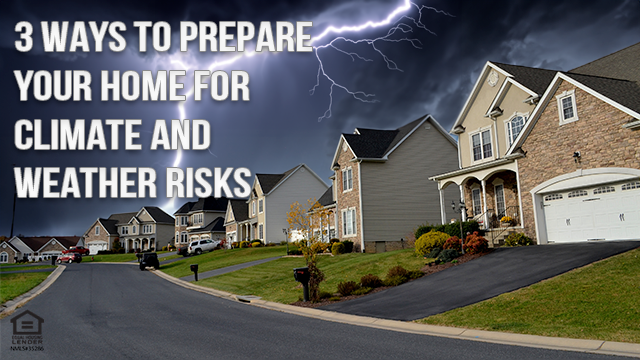
3 Ways to Prepare Your Home for Climate and Weather Risks

Florida hurricanes, earthquakes in California, tornadoes in the Midwest- there are geographical and weather risks associated with every part of the country.
Severe weather events are expected to intensify in coming years, causing more extreme wind damage, rainfall, and storm surges. It's more important than ever for homeowners to understand and mitigate the risks associated with their home.
How Many Homes Are At-Risk in the US?
Climate risk extends to a wide range of potential threats, including extreme temperatures, rising sea levels, changing precipitation patterns, and an increased severity of weather events.
According to Columbia Climate School, U.S. Geological Survey, and First Street Foundation,
- 14.6 million U.S. homes are at substantial risk of flooding
- Nationwide, an estimated 71.8 million homes are at risk of wildfire damage
- At least 97 million people in the contiguous U.S. live in areas at risk for earthquakes capable of causing structural damage
1. Assess Your Climate Risk
The popular phrase “location, location, location!” also applies to climate risk. Before purchasing a property, learn about the potential for severe weather.
Does your ocean view come with a risk of hurricanes or mudslides? Is your West Coast home in a wildfire zone? Does the warmer climate often lead to droughts?
If the answer is “yes,” that doesn’t mean you need to move to a low-risk region, but it’s important to understand and prepare for any challenges that come with your new property.
The following websites offer tools to help you assess property risks and offer tips on how to alleviate them:
- ClimateCheck
- First Street Foundation
- FEMA
- FloodSmart.gov
- U.S. Geological Survey
2. Protect Your Home
Once you know the likely risks to your home, you can make improvements to protect against those threats:
- Install wind-resistant doors, windows, and storm shutters
- Anchor heavy furniture to walls
- Trim trees and bushes to reduce storm debris
- Landscape with nonflammable materials, such as stone or cement
- Locate water, gas, and electrical lines and learn how to turn them off
If protecting your home is going to take a large financial investment, you may be able to use your home’s equity to pay for improvements.
3. Double-Check Your Insurance Policy
Many homeowners’ insurance policies cover damage from threats like fire, lightning, wind, and hail, but don’t wait until after a loss to find out what your coverage is.
Determine whether your policy will cover damage at replacement cost (what it will cost you to repair or replace an item) or actual cash value (what your property and possessions are worth, minus depreciation).
Two major costs that are not covered by standard policies are flooding and earthquakes. This coverage must be purchased separately, and its cost depends on how likely this type of damage is.
Closing Thoughts
While climate risks vary depending on where you’re located in the country, it’s important to remain knowledgeable and prepared for possible threats or emergencies. Your home is one of your greatest investments, so it’s more than worth taking the time to ensure it’s properly protected.